#Steve Carruthers
Text

Bad movie I have An Affair to Remember 1957
#An Affair to Remember#Cary Grant#Deborah Kerr#Richard Denning#Neva Patterson#Cathleen Nesbitt#Robert Q. Lewis#Charles Watts#Fortunio Bonanova#Dorothy Adams#Richard Allen#Al Bain#Frank Baker#Mary Bayless#Dino Bolognese#Paul Bradley#George Calliga#Mary Carroll#Steve Carruthers#Norman Champion III#Kathleen Charney#Brian Corcoran#Walt Davis#Anthony De Mario#Ken DuMain#Minta Durfee#Michka Egan#Suzanne Ellers#Juney Ellis
3 notes
·
View notes
Text

[2102/11056] Carruthers's cisticola - Cisticola carruthersi
Order: Passeriformes
Suborder: Passeri
Superfamily: Sylvioidea
Family: Cisticolidae (cisticolid warblers)
Photo credit: Steve McInnis via Macaulay Library
#birds#Carruthers's cisticola#Passeriformes#Passeri#Sylvioidea#Cisticolidae#Cisticola#birds a to z#undescribed
87 notes
·
View notes
Photo


Burke’s Law - List of Guest Stars
The Special Guest Stars of “Burke’s Law” read like a Who’s Who list of Hollywood of the era. Many of the appearances, however, were no more than one scene cameos. This is as complete a list ever compiled of all those who even made the briefest of appearances on the series.
Beverly Adams, Nick Adams, Stanley Adams, Eddie Albert, Mabel Albertson, Lola Albright, Elizabeth Allen, June Allyson, Don Ameche, Michael Ansara, Army Archerd, Phil Arnold, Mary Astor, Frankie Avalon, Hy Averback, Jim Backus, Betty Barry, Susan Bay, Ed Begley, William Bendix, Joan Bennett, Edgar Bergen, Shelley Berman, Herschel Bernardi, Ken Berry, Lyle Bettger, Robert Bice, Theodore Bikel, Janet Blair, Madge Blake, Joan Blondell, Ann Blyth, Carl Boehm, Peter Bourne, Rosemarie Bowe, Eddie Bracken, Steve Brodie, Jan Brooks, Dorian Brown, Bobby Buntrock, Edd Byrnes, Corinne Calvet, Rory Calhoun, Pepe Callahan, Rod Cameron, Macdonald Carey, Hoagy Carmichael, Richard Carlson, Jack Carter, Steve Carruthers, Marianna Case, Seymour Cassel, John Cassavetes, Tom Cassidy, Joan Caulfield, Barrie Chase, Eduardo Ciannelli, Dane Clark, Dick Clark, Steve Cochran, Hans Conried, Jackie Coogan, Gladys Cooper, Henry Corden, Wendell Corey, Hazel Court, Wally Cox, Jeanne Crain, Susanne Cramer, Les Crane, Broderick Crawford, Suzanne Cupito, Arlene Dahl, Vic Dana, Jane Darwell, Sammy Davis Jr., Linda Darnell, Dennis Day, Laraine Day, Yvonne DeCarlo, Gloria De Haven, William Demarest, Andy Devine, Richard Devon, Billy De Wolfe, Don Diamond, Diana Dors, Joanne Dru, Paul Dubov, Howard Duff, Dan Duryea, Robert Easton, Barbara Eden, John Ericson, Leif Erickson, Tom Ewell, Nanette Fabray, Felicia Farr, Sharon Farrell, Herbie Faye, Fritz Feld, Susan Flannery, James Flavin, Rhonda Fleming, Nina Foch, Steve Forrest, Linda Foster, Byron Foulger, Eddie Foy Jr., Anne Francis, David Fresco, Annette Funicello, Eva Gabor, Zsa Zsa Gabor, Reginald Gardiner, Nancy Gates, Lisa Gaye, Sandra Giles, Mark Goddard, Thomas Gomez, Pedro Gonzalez Gonzalez, Sandra Gould, Wilton Graff, Gloria Grahame, Shelby Grant, Jane Greer, Virginia Grey, Tammy Grimes, Richard Hale, Jack Haley, George Hamilton, Ann Harding, Joy Harmon, Phil Harris, Stacy Harris, Dee Hartford, June Havoc, Jill Haworth, Richard Haydn, Louis Hayward, Hugh Hefner, Anne Helm, Percy Helton, Irene Hervey, Joe Higgins, Marianna Hill, Bern Hoffman, Jonathan Hole, Celeste Holm, Charlene Holt, Oscar Homolka, Barbara Horne, Edward Everett Horton, Breena Howard, Rodolfo Hoyos Jr., Arthur Hunnicutt, Tab Hunter, Joan Huntington, Josephine Hutchinson, Betty Hutton, Gunilla Hutton, Martha Hyer, Diana Hyland, Marty Ingels, John Ireland, Mako Iwamatsu, Joyce Jameson, Glynis Johns, I. Stanford Jolley, Carolyn Jones, Dean Jones, Spike Jones, Victor Jory, Jackie Joseph, Stubby Kaye, Monica Keating, Buster Keaton, Cecil Kellaway, Claire Kelly, Patsy Kelly, Kathy Kersh, Eartha Kitt, Nancy Kovack, Fred Krone, Lou Krugman, Frankie Laine, Fernando Lamas, Dorothy Lamour, Elsa Lanchester, Abbe Lane, Charles Lane, Lauren Lane, Harry Lauter, Norman Leavitt, Gypsy Rose Lee, Ruta Lee, Teri Lee, Peter Leeds, Margaret Leighton, Sheldon Leonard, Art Lewis, Buddy Lewis, Dave Loring, Joanne Ludden, Ida Lupino, Tina Louise, Paul Lynde, Diana Lynn, James MacArthur, Gisele MacKenzie, Diane McBain, Kevin McCarthy, Bill McClean, Stephen McNally, Elizabeth MacRae, Jayne Mansfield, Hal March, Shary Marshall, Dewey Martin, Marlyn Mason, Hedley Mattingly, Marilyn Maxwell, Virginia Mayo, Patricia Medina, Troy Melton, Burgess Meredith, Una Merkel, Dina Merrill, Torben Meyer, Barbara Michaels, Robert Middleton, Vera Miles, Sal Mineo, Mary Ann Mobley, Alan Mowbray, Ricardo Montalbán, Elizabeth Montgomery, Ralph Moody, Alvy Moore, Terry Moore, Agnes Moorehead, Anne Morell, Rita Moreno, Byron Morrow, Jan Murray, Ken Murray, George Nader, J. Carrol Naish, Bek Nelson, Gene Nelson, David Niven, Chris Noel, Kathleen Nolan, Sheree North, Louis Nye, Arthur O'Connell, Quinn O'Hara, Susan Oliver, Debra Paget, Janis Paige, Nestor Paiva, Luciana Paluzzi, Julie Parrish, Fess Parker, Suzy Parker, Bert Parks, Harvey Parry, Hank Patterson, Joan Patrick, Nehemiah Persoff, Walter Pidgeon, Zasu Pitts, Edward Platt, Juliet Prowse, Eddie Quillan, Louis Quinn, Basil Rathbone, Aldo Ray, Martha Raye, Gene Raymond, Peggy Rea, Philip Reed, Carl Reiner, Stafford Repp, Paul Rhone, Paul Richards, Don Rickles, Will Rogers Jr., Ruth Roman, Cesar Romero, Mickey Rooney, Gena Rowlands, Charlie Ruggles, Janice Rule, Soupy Sales, Hugh Sanders, Tura Satana, Telly Savalas, John Saxon, Lizabeth Scott, Lisa Seagram, Pilar Seurat, William Shatner, Karen Sharpe, James Shigeta, Nina Shipman, Susan Silo, Johnny Silver, Nancy Sinatra, The Smothers Brothers, Joanie Sommers, Joan Staley, Jan Sterling, Elaine Stewart, Jill St. John, Dean Stockwell, Gale Storm, Susan Strasberg, Inger Stratton, Amzie Strickland, Gil Stuart, Grady Sutton, Kay Sutton, Gloria Swanson, Russ Tamblyn. Don Taylor, Dub Taylor, Vaughn Taylor, Irene Tedrow, Terry-Thomas, Ginny Tiu, Dan Tobin, Forrest Tucker, Tom Tully, Jim Turley, Lurene Tuttle, Ann Tyrrell, Miyoshi Umeki, Mamie van Doren, Deborah Walley, Sandra Warner, David Wayne, Ray Weaver, Lennie Weinrib, Dawn Wells, Delores Wells, Rebecca Welles, Jack Weston, David White, James Whitmore, Michael Wilding, Annazette Williams, Dave Willock, Chill Wills, Marie Wilson, Nancy Wilson, Sandra Wirth, Ed Wynn, Keenan Wynn, Dana Wynter, Celeste Yarnall, Francine York.
7 notes
·
View notes
Text

Lana Turner and Juanita Moore in Imitation of Life (Douglas Sirk, 1959)
Cast: Lana Turner, Juanita Moore, John Gavin, Susan Kohner, Sandra Dee, Robert Alda, Dan O'Herlihy, Karin Dicker, Terry Burnham, Troy Donahue, Mahalia Jackson. Screenplay: Eleanore Griffin, Allan Scott,
based on a novel by Fannie Hurst. Cinematography: Russell Metty. Art direction: Alexander Golitzen, Richard H. Riedel. Film editing: Milton Carruth. Music: Frank Skinner.
John Gavin was Hollywood's ultimate decorative male, there to look good in bed with Janet Leigh in Psycho (Alfred Hitchcock, 1960) but otherwise to play no significant role in the film. (When he shows up later with Vera Miles, playing Leigh's sister, to find out what happened to Marion Crane, she's the one who does all the work, including the discovery of the mummified Mrs. Bates in the cellar.) It's no surprise that when Gavin died a few years ago, several of the obituaries mentioned the scene in Thoroughly Modern Millie (George Roy Hill, 1967) in which his character is paralyzed by a poison dart: He's been presented as so handsomely wooden that it takes a long time before anyone notices he's just sitting there. He's not quite so inert in Imitation of Life, but that's because Douglas Sirk, like Hitchcock, knew how to make use of him: He's there to hang as nicely on Lana Turner's arm as the Jean Louis gowns do on her body. Unfortunately, this makes for some of the film's weaker scenes, the ones in which Sandra Dee's Susie develops a crush on him, but even there the fault is more Dee's limitations as an actress than Gavin's as an actor. He comes off much better in one of the key scenes, in which his Steve Archer proposes to Turner's Lora Meredith. It works because Turner is skillful enough to make Lora into a woman who knows how not to get trapped by male expectations of what women should be. It's not quite so well-played as the scene in Now, Voyager (Irving Rapper, 1942) I wrote about a couple of days ago, in which Charlotte Vale rebuffs Jerry Durrance's suggestion that she should be looking for a man instead of taking care of his daughter, but that's because Lana Turner wasn't Bette Davis. Still, the scene comes off, and it's reinforced later when Lora is the one who proposes to Steve, after she's gotten what she wanted. The film belongs, of course, to the women, not only Turner but also and especially to Juanita Moore and Susan Kohner, who got the Oscar nominations they deserved. It's possible to fault the film for "whitewashing" by casting Kohner as the Black girl who tries to pass for white, especially since in the earlier version of Imitation of Life (John M. Stahl, 1934), the corresponding character was played by Fredi Washington, who was indeed Black. But even to raise the issue of "passing" in 1959, especially in a film that some considered little more than soap opera, was audacious: The Production Code had long forbidden any treatment of miscegenation. And Sirk artfully turns the issue into a generational one: Sarah Jane's desire to be white as a reaction against the subservience of her mother, foreshadowing a generation gap that would be operative in the coming decade's civil rights struggle. Sirk's films have a way of working themselves into your head unexpectedly, putting the lie to my observation that drama makes you think and melodrama makes you feel. Sirk's melodrama -- Imitation of Life is unashamed of the clichés it exploits and usually transcends -- undoubtedly makes you feel. Is there ever a dry eye at showings of the film's funeral finale? But by confronting the problems that underlie the melodrama it also has a sneaky way of making you think.
6 notes
·
View notes
Text

Here's a clue.
If you look at the BJU University Leadership listing, a few things become obvious. Look at the list of BJU employees. Let's cross off the ones that signed that big ultimatum letter to the Board.
Gary Weier, PhD
Alan Benson, DMin
John Matthews, MBA
Bobby Wood, PhD
Steve Dickinson, BS
Carol Keirstead, MS
David Fisher, PhD
Beverly Cormican, EdD
Kevin Taylor, MS
David Lovegrove, BS
Renton Rathbun, PhD
Renae Wentworth, EdD
Darren Lawson, PhD
Brian Carruthers, EdD
Richard Stratton, PhD
Jessica Minor, PhD
Kevin Oberlin, PhD
Neal Cushman, PhD
Pattye Casarow, DMA
Brian Trainer, MDiv
Daniel Smith, EdD
Brian Burch, MBA
Susan Wise, BS
Phillip Gerard, MA
Doug Garland, EdD
Jonathan Daulton, MDiv
Deneen Lawson, BAPCT
Neal Ring, EdD
Let's keep going. Here's who's left. Now there are some folks that are out of the running right off: those with ladybits and those who are behind-the-scenes folks.
Carol Keirstead, MS
Kevin Taylor, MS
David Lovegrove, BS
Renton Rathbun, PhD
Pattye Casarow, DMA
Brian Trainer, MDiv
Daniel Smith, EdD
Brian Burch, MBA
Susan Wise, BS
Jonathan Daulton, MDiv
Deneen Lawson, BAPCT
Neal Ring, EdD
Now who's left?
Renton Rathbun, PhD
Brian Trainer, MDiv
Jonathan Daulton, MDiv
Are these three of the candidates for the next president of BJU? They could be considered "pastors" of some variety.
#Bob Jones University#Make BJu President Exist Again#Make BJU Great Again#Renton Rathbun#Brian trainer#Jonathan Daulton
1 note
·
View note
Text
How To Conduct A Podcast interview That Listeners Will Enjoy
Practicing and aspiring podcasters expend a lot of energy on choosing a topic, developing episodes and scripts, and then preparing the recording software and hardware. One area, however, where they often assume experience and skills not finely tuned, is in interviewing guests on the podcast.
Typical podcast host responses to prepare for interviews include:
“I’m good at talking with people.”
“I’m a good listener.”
“I’ll just ask a few questions and the guest does all the work.”
Unfortunately, interviewing guests on a podcast (or in any medium from radio to TV) is a dark art that can seem as obtuse as reading palms.
“Many podcast creators and hosts assume that the guest or guests they interview have the same goals as they do,” says podcast consultant George Witt.
Witt notes that guests typically have three objectives when they are interviewed on a podcast. First, they are selling something, usually a book or at times a lifestyle program like a diet or fitness regimen. Second, they want to demonstrate to the listeners how smart and knowledgeable they are because that often assists with the first goal. Third, they want listeners to absorb and then readily agree with whatever point of view they are espousing.
Listening for Interest
Long-time host of Something You Should Know (either via radio or podcast) Mike Carruthers has been interviewing guests for more than 20 years.
“The toughest part of a podcast interview is keeping it interesting,” explains Carruthers in an interview we did last year. “I have a little voice in my head that keeps asking me right from the start of every interview, ‘Is this fascinating?’ Or ‘Is this going on too long?’ Or ‘Is he/she really answering the question?’ I try to assume the mindset of the listener. And in my view, a listener wants every interview to get interesting — FAST. It would be easy to let people talk in the beginning about how they got interested in the topic or what is their background. But I don’t think that’s what an audience wants to hear first. They want to hear why this is interesting to them and why they should be listening. Then once they care about someone, then they might be interested in their background.”
Carruthers goes on, “that’s why I think editing is so important. I’ve done interviews where the first several minutes are edited out because the guest was just warming up. They didn’t get interesting until six or seven minutes into the interview. So in the show, that’s where the interview starts.”
“Sometimes interviews aren’t as linear as we think,” says Witt. “More often than you think, podcasts will move a particularly interesting section of the interview to the front of the segment to grab the audiences’ attention.”
“That’s a smart move,” Witt adds. “That’s why carefully editing an interview is so critical.”
Witt applauds Carruthers on Something You Should Know because the veteran podcaster ask all guests to watch a short video that tells people exactly what we expect from them
“Podcasters who feel that preparing for an interview ruins the spontaneity are usually asking for trouble,” Witt explains. “For example, there are guests that after the first question the host asks are off to the races blurting out information at a machine-gun pace.
“By the time you, as the host, are ready to ask a second question, the guest has already overwhelmed you and eventually the listener with an info dump and the guest has little more to add.”
Interviewing tips
So what can a podcast host do to ensure that an interview goes smoothly and captures your listeners’ interest?
First, don’t rely on the cursory information you may possess on a guest. Do a deeper dive.
“Some of the best podcast interviews happen when a host discovers something not well known about a guest,” says George Witt. “For example, check out the People I (Mostly) Admire podcast, where host economist Steve Levitt interviews actor Mayim Bialik of Big Bang Theory fame and uses his extensive research to go beyond the typical celebrity queries.”
Second, institute some kind of pre-interview procedures. Prepare questions and then possible follow-up questions ahead of time, then send the questions to your guest. Many people frown on allowing guests to view your questions before the interview but since you’re recording a podcast not Meet the Press where you’re confronting some politician or bureaucrat who’s lying to cover up the president’s lies, it’s solid strategy, so your guest can be prepared or reach out to you with any concerns.
As mentioned earlier, the Something You Should Know podcast sends a link to a video that details the interview process on the podcast. You should let your guest know if you’ll edit the interview.
“My guests feel a lot more comfortable knowing I’ll be editing later,” explains Witt. “This way, a mistake can be easily fixed and that relaxes the guest.”
Third, the focus of the interview should be on the guest, so try not to interrupt and use your words to keep the interview focused and moving forward. As an interviewer, practice active listening, which means to listen and then process what your guest is saying and then ask pertinent questions based on their comments.
Too many hosts simply follow a script of questions regardless of what the guest just said, often missing an opportunity for revelation. One of many reasons why The New York Times’ podcast The Daily is so popular is that host Michael Barbaro is a superb interviewer. His questions are incisive and probing, and he listens well to his guests and then reacts with a follow-up query that shows understanding and a desire to know more.
Fourth, work with your interview subject to disperse information to your listeners so that there is a consistent flow that creates a compelling narrative.
“A good podcast interview is like putting together a Lego® set,” adds George Witt. “As the host, you carefully connect the pieces so that your listeners can picture the interview as a coherent whole.”
Finally, a good interviewer is not afraid of a little silence during an interview.
“A time-honored interviewing tip is to ask a question,” begins George Witt, “and if you’re met with silence initially, don’t fill that void but be patient and wait for an answer. You’d be amazed how people feel so uncomfortable with silence that they will respond in surprising and unscripted ways.”
The French philosopher Voltaire once said, “Judge a man by his questions rather than by his answers.”
0 notes
Text
CLAN CARRUTHERS: Update on Carruthers DNA Snp
CLAN CARRUTHERS: Update on Carruthers DNA Snp
Our Director of DNA research Mr Steve Colburn has issued this update and statement. It underlines the need for good research based on evidence, tenacity and accuracy. As such if it’s not published on this site, it has not been fact checked for its validity with regards Carruthers
WILL THE REAL CARRUTHERS SNP MARKER PLEASE COME FORWARD
Hello All – Just a little information about the Carruthers…
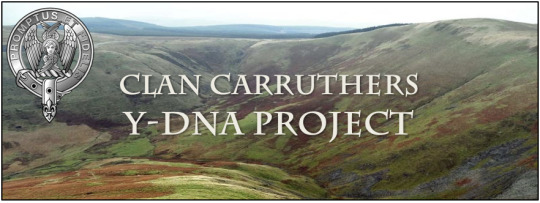
View On WordPress
0 notes
Text
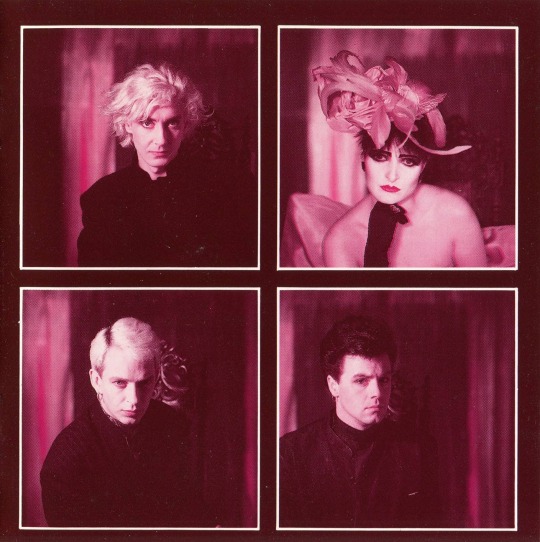
SIOUXSIE AND THE BANSHEES
#siouxsie and the banshees#siouxsie sioux#steve severin#budgie#post-punk#alternative rock#gothic rock#new wave#john valentine carruthers#tinderbox#rock
278 notes
·
View notes
Text
Lucy Meets a Millionaire
S2;E24 ~ March 16, 1964
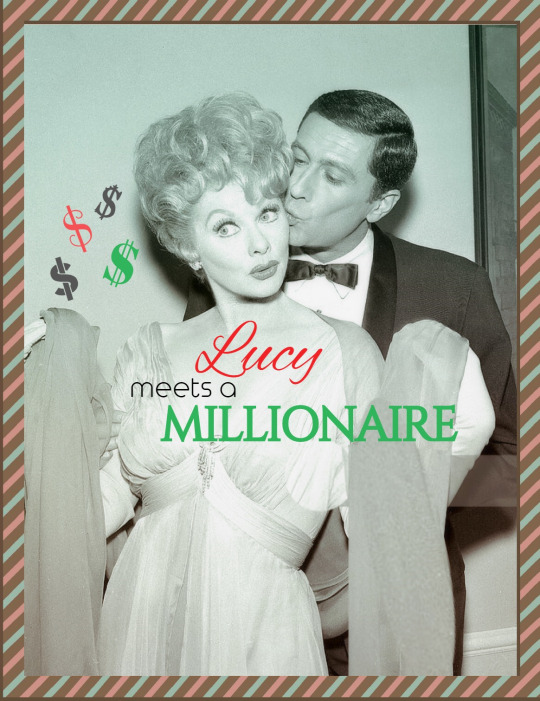

Synopsis
When Lucy gets a flat tire, a handsome rich Italian man comes to her rescue. On a date night out, Lucy accidentally spills pasta on him and she must break in to a local cleaners to retrieve his other suit so they won't miss the St. Patrick's Day dance. Breaking in through the skylight, Lucy falls into vat of green dye.
Regular Cast

Lucille Ball (Lucy Carmichael), Vivian Vance (Vivian Bagley), Gale Gordon (Theodore J. Mooney)
Candy Moore (Chris Carmichael), Jimmy Garrett (Jerry Carmichael) and Ralph Hart (Sherman Bagley) do not appear in this episode.
Guest Cast

Cesare Danova (Umberto Fabriani) was born in Italy in 1926. He appeared opposite Elizabeth Taylor in Cleopatra, but much of his role was cut to highlight the romance between Taylor and Richard Burton. Danova was on the short list to play the lead in Ben-Hur (1959) but Charleton Heston was cast instead. In 1978, he played the Mayor in National Lampoon's Animal House. This is his only appearance with Lucille Ball.
Umberto is a millionaire (several times over, according to Mr. Mooney) who is with the firm of Fabriani and Fabriani, partnered with his elderly father.
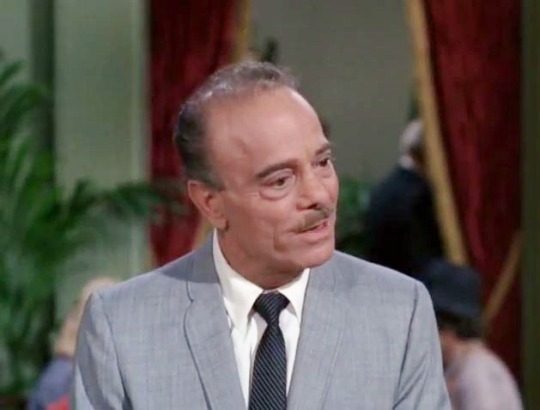
Jay Novello (Tony DiBello) was born Michael Romano in Chicago in 1904 to Italian parents and was fluent in the language before learning English. He played Mr. Merriweather in “The Seance” (ILL S1;E7) and returned to the series to play the nervous Mr. Beecher in “The Sublease” (ILL S3;E31) and Mario Orsatti, the “Visitor from Italy” (ILL S6;E5). Novello previously played ex-con candy store owner Mr. Bundy in “Lucy and the Safecracker” (S2;E6). Coincidentally, Novello’s second wife went by the nickname ‘Lucy’. In 1965 he played the recurring character Mayor Mario Lugatto on “McHale’s Navy.”
Tony DiBello is the proprietor of Tony DiBello's Italian Restaurant.
Steve Carruthers (Maitre d', uncredited) was one of the passengers on the S.S. Constitution in “Second Honeymoon” (ILL S5;E14). He was seen in the Lucille Ball / Bob Hope film The Facts of Life. This is the first of his two appearances on “The Lucy Show.”
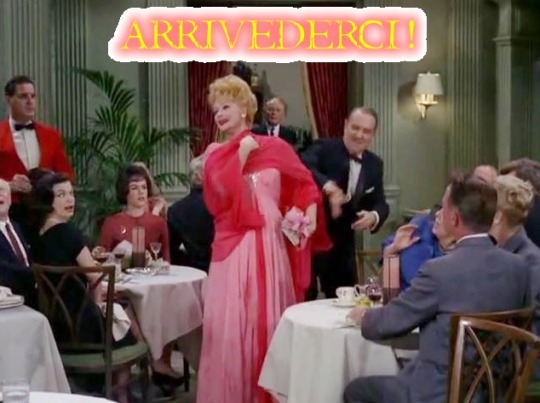
James Gonzales (Restaurant Patron, uncredited) was a popular Hollywood extra who first acted with Lucille Ball in the 1953 film The Long, Long Trailer. He was previously seen on the series as Stan Williams in “Lucy Digs Up a Date” (S1;E2). He was seen in more than 20 episodes of “The Lucy Show” and 3 episodes of “Here’s Lucy.”
Bert Stevens (Restaurant Patron, uncredited) made many appearances as background players on the series. He was the brother of actress Barbara Stanwyck, whose given name was Ruby Stevens. He was seen in the Tropicana audience for the Flapper Follies when “Ricky Loses His Voice” (ILL S2;E9) but probably appeared on other episodes as well. He often appeared with his wife, Caryl Lincoln, one of Lucille Ball's friends from her Goldwyn Girl days.
Jean Vachon (Restaurant Patron, uncredited) makes the second of her six appearances on “The Lucy Show,” all but one uncredited.
A other dozen other uncredited background actors play the diners at Tony DiBello's.
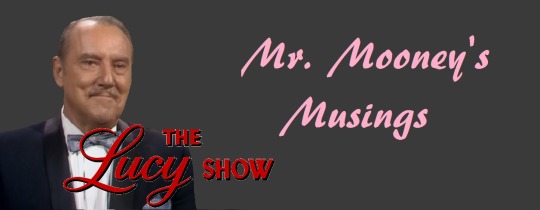
This episode was filmed on February 6, 1964.
As season two goes on, the plots feature less of Vivian Vance, who was tiring of her commute from Hollywood to her Connecticut home.
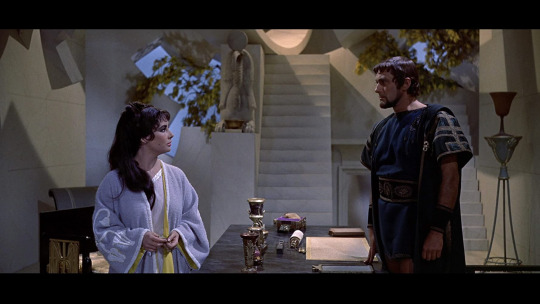
Coincidentally, the day before this episode first aired (March 15, 1964) Richard Burton and Elizabeth Taylor married. They had just starred as lovers in the film Cleopatra (above), which also featured Cesare Danova (Umberto). Lucy Carmichael played Cleopatra on the season two opener of “The Lucy Show.” Burton and Taylor would appear with Lucille Ball in a 1970 episode of “Here's Lucy.”

In another coincidence, the episode of “Make Room for Daddy” that followed “The Lucy Show” on CBS on March 16, 1964, also had an Italian theme. The guest star was Italian born singer singer Piccola Pupa, a young performer Danny Thomas claims to have 'discovered.'
Ironically, when this episode was filmed, Lucille Ball herself was a millionaire. Lucy and Desi were the first millionaire TV stars in history.
Dede's Dress Shop is mentioned for the second episode in a row. Dede Ball was Lucille Ball's mother.

The name ‘Tony Di Bello’ was created by the writers as a nod to the name of their secretary Elaine's father, Mr. Tony Di Bello.
Mr. Mooney invites Umberto and Lucy to join him and his wife Irma at the St. Patrick's Day dance. This episode was first broadcast on St. Patrick's Day eve 1964. In real-life, Cesare Danova was a fan of all things Irish. He ever carried a small leprechaun around with him wherever he went.
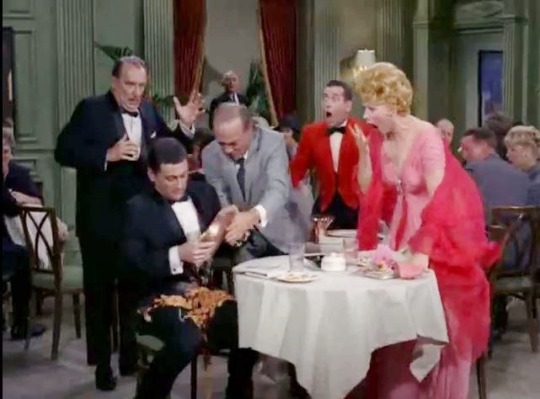
When Lucy spills pasta in Umberto's lap, he says his other tux is at Oscar's Cleaners. Lucy Carmichael says that she has known Oscar for years. He is unmarried and a trophy-winning bowler for his team, Oscar's Tigers. Reading from a distance, Lucy mistakenly thinks his name is Oscar Stigers.
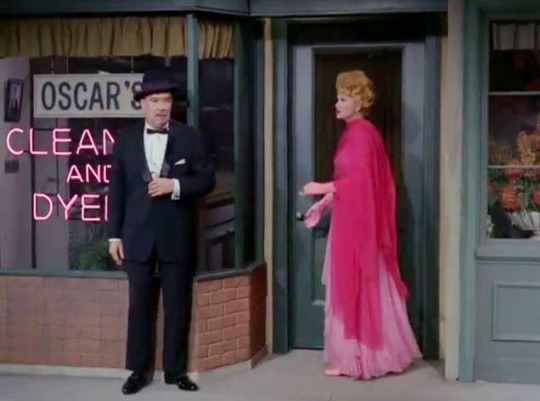
Oscar's Cleaners is next door to a Florist shop owned by Meryl. Lucy does not know Meryl's surname either. Mr. Mooney says the one person who knows everyone's last name in town is George the mailman.
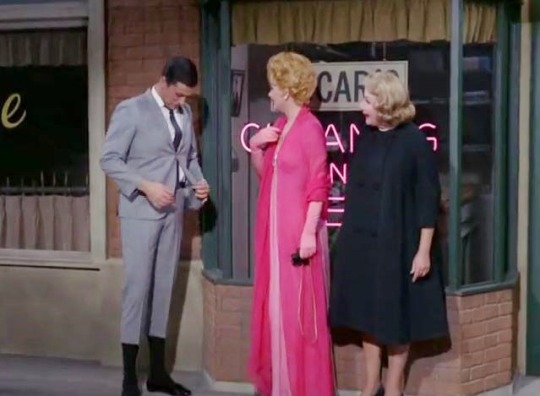
Lucy asks Mr. Mooney for a dime for the pay phone. In New York, it cost ten cents to use a payphone until 1982, when it was raised to twenty five cents. In the early 1950s (during “I Love Lucy”) the cost was only five cents. Today, pay phones are nearly obsolete due to the proliferation of mobile (cell) phones.

Lucy ends up getting covered in green dye. Unfortunately, although filmed in color, CBS originally broadcast this episode in black and white!
Callbacks!
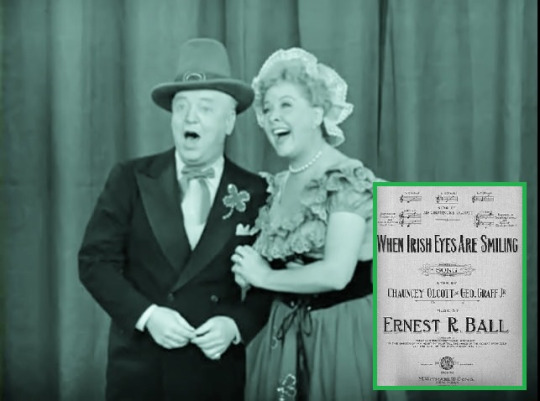
In “Bullfight Dance” (ILL S4;E23) Fred and Ethel croon “When Irish Eyes Are Smiling” by Ernest R. Ball (no relation). This is the closest the series gets to a St. Patrick’s Day mention. Fred Mertz was said to be of Irish extraction.
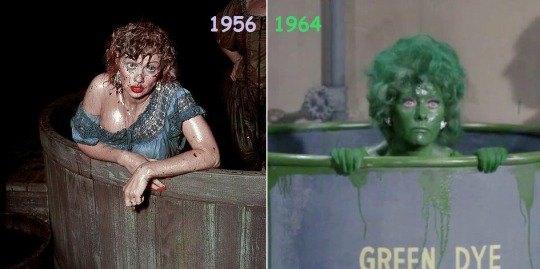
The finale of “Lucy's Italian Movie” (ILL S5;E23) had Lucy dyed purple when she had a fight in a wine vat of grapes.
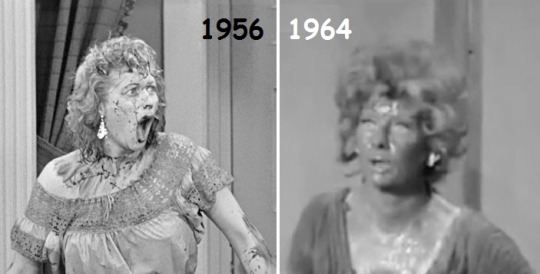
That episode, too, was originally broadcast in black and white, but was colorized in 2013.

When the gang went to Europe on “I Love Lucy” it was Ethel (Vivian Vance) who was in charge of learning Italian, while Lucy learned French.

The note Lucy Carmichael writes on the back of her check reads: “Dear cashier, be a love and clear this before you-know-who gets back.” The message is very similar to the note Lucy Ricardo wrote on the back of a check in “Job Switching” (ILL S2;E1), “Dear teller, be a lamb and don't put this through until next month.”
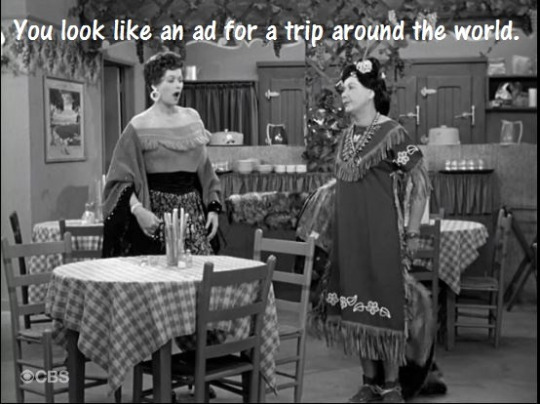
A heavily disguised Lucy and Ethel meet their husbands at Tony’s Italian Restaurant in “The Black Wig” (ILL S3;E26).
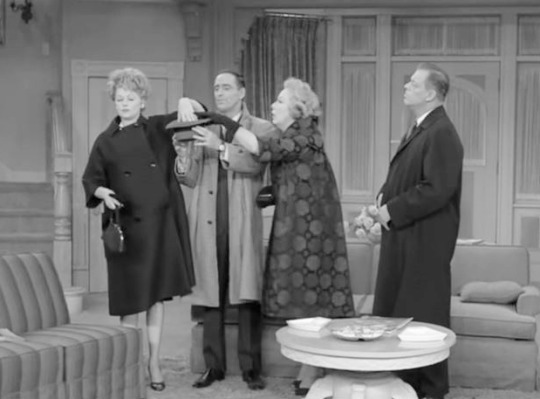
In “No More Double Dates” (S1;E21) Lucy’s boyfriend Harry (Dick Martin) suggests going to Tony DiBello’s for Italian food.
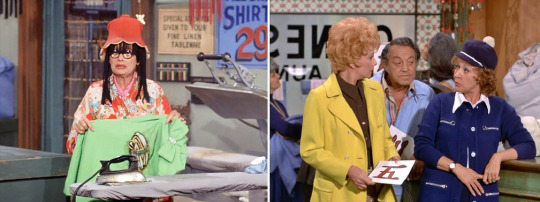
There was trouble at the cleaners (in this case Chinese Laundries) on “Here’s Lucy” in both “Lucy the Laundress” (HL S2;E17) and “Lucy and the Chinese Curse” (HL S4;E18).
It’s Not Easy Bein’ Green!
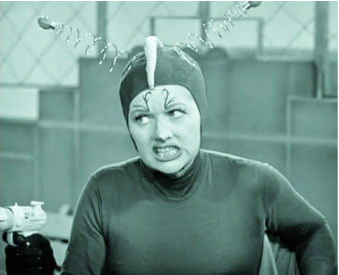
Lucille Ball may also have been green when playing a woman from Mars in “Lucy is Envious” (ILL S3;E23) in 1954, but since the episode was filmed in black and white, we will never know for sure!

LUCY RICARDO: “My face! My hair! Oh, no! I’m looking at the world through green colored eyeballs!”
Green light bulbs turn Lucy (and everyone else) green when “Lucy Fakes Illness” (ILL S1;E16). Again, because the episode was filmed in black and white, viewers never see the effects of the ‘gobloots’ (aka green bulb)!

LUCY CARMICHAEL: “Who’d they make these pajamas for - the Jolly Green Giant?”
Stuck in isolation in “Lucy and the Astronauts” (TLS S4;E5) Lucy has to wear over-sized men’s green pajamas. The Jolly Green Giant is the advertising character used to promote Green Giant Frozen Vegetables.

VIV: “Take off that hat! It looks like a fresh crop of crab grass!”
When “Lucy Goes To Vegas” (TLS S3;E17), she wears the emerald green spangled gown and matching green feathered hat won for being Bigelow’s Department Store’s one millionth customer.
Fast Forward!
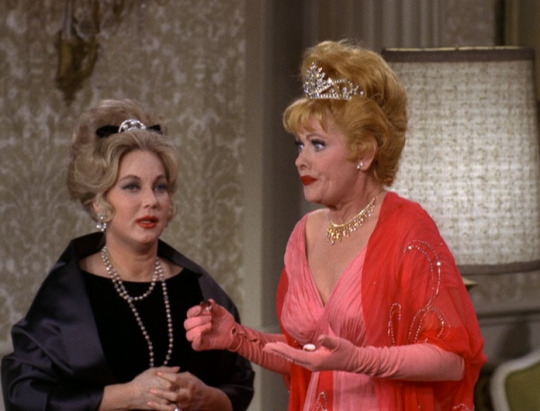
A year later, Lucy will wear this same salmon colored gown (with a different red wrap) in “My Fair Lucy” (ILL S3;E20) when she goes to a fancy soiree with the Countess (Ann Sothern).
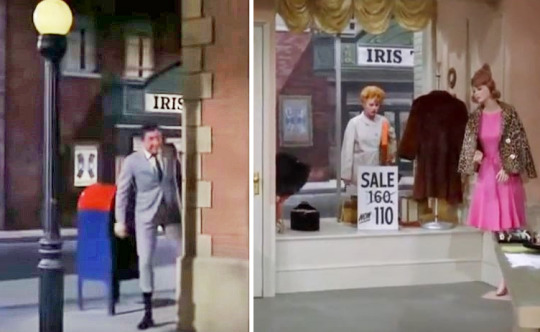
The backdrop used for the Danfield street depicts the Iris Theatre. This same backdrop will be used again outside of Madame Fifi’s Fur Shop when “Lucy Gets Amnesia” (S3;E4). This may be an homage to Los Angeles’ legendary Iris Theatre, which reportedly had the first electric sign in Hollywood. It may also be an homage to the character Iris Atterbury, Liz Cooper’s sidekick (played by Bea Benadaret) on Lucille Ball’s radio show “My Favorite Husband.”
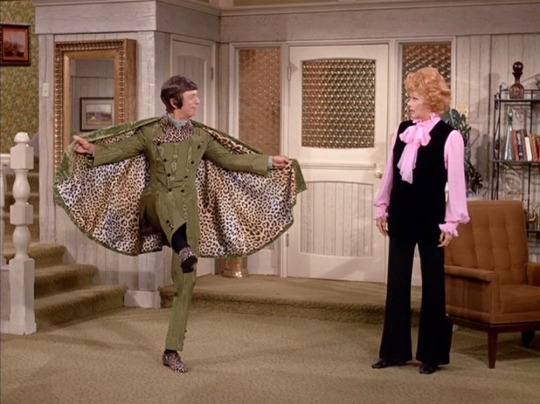
Lucy Carter dated a prospective millionaire played by Don Knotts in “Lucy’s Last Blind Date” (HL S5;E16).

When Lucy Carter meets a homeless man in the park, she believes him to be a ‘Howard Hughes-like’ millionaire she read about in the newspaper and “Lucy, The Philanthropist” goes into action!
Blooper Alerts!
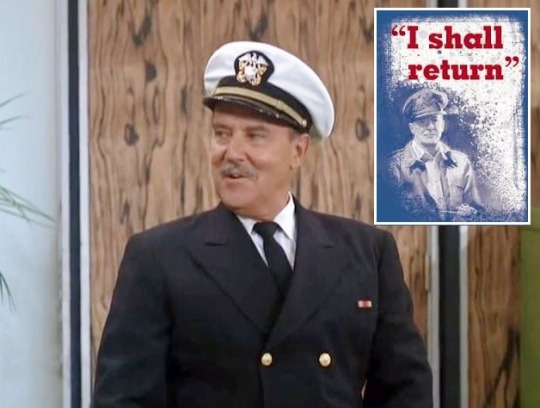
Stolen Valor? Mr. Mooney speaks Italian quite well. He says he "picked up a few words in the Army." In “Lucy and the Submarine” (S5;E2, above), however, Mr. Mooney says he was actually a Navy housing officer stationed just outside of Wichita during World War II. Is he a pathological liar of the victim of forgetful writers?
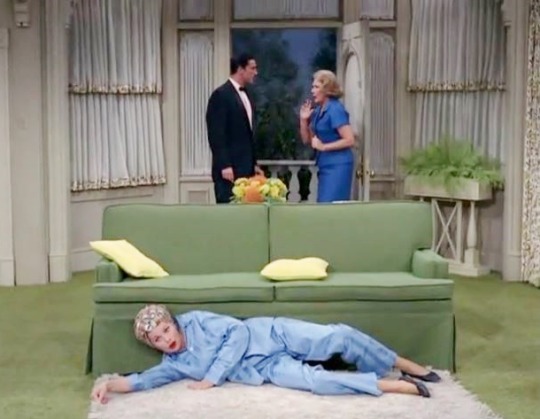
Noises Off! When Umberto arrives unexpectedly (with Lucy in pajamas and curlers) a high pitched voice in the audience clearly says “Oh, no!” Lucy's husband Gary Morton can also be heard laughing on the soundtrack. Later, when Umberto mentions having taken a taxi, a voice from the audience clearly echos “Taxi!”
Boom Shadows! When Lucy drops to the floor behind the sofa upon Umberto’’s sudden appearance at her front door, the shadow of a boom microphone passes over Lucy.

Fickle Furniture! For this episode, the large oval dining room table has been replaced by a smaller round table for Lucy's ‘ghostly’ get-away gag. Although it is nearly identical, the living room sofa was either adapted or duplicated to allow Lucille Ball enough space to freely roll underneath it.
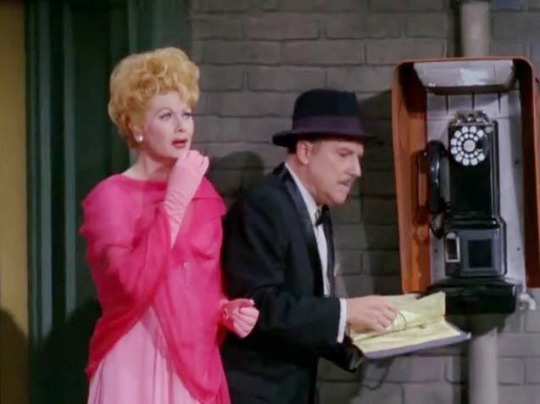
Let Your Fingers Do the Walking! When Lucy is trying to remember Oscar's last name to look him up in the telephone directory, Mr. Mooney is looking through the Yellow Pages, which are organized by business names, not surnames. They would not need to know Oscar's last name to find his work phone number, just his home number.

Broken Fingers! When Mr. Mooney roughly drops the phone book the second time it comes loose from the hard blue cover that connects it to the phone and the book breaks in two! When Gale Gordon needs to look up “George the Mailman” he has to bend down (out of frame) to pick it up off the floor and scoop up the tattered book to complete the scene.
Sitcom Logic Alert! Lucy immediately knows that Oscar's bowling trophy must have been made by the National Bowling Company in Chicago. Lucy is a font of useless knowledge!
Dry Dye! As Umberto races into the back room of the cleaners to rescue Lucy, he bumps into the vat of green dye and it moves quite easily. If it was actually full of liquid, the weight would prevent it from moving at all. Also, when Lucy is fished out she isn't dripping wet, despite the sloshing sound effects to the contrary.
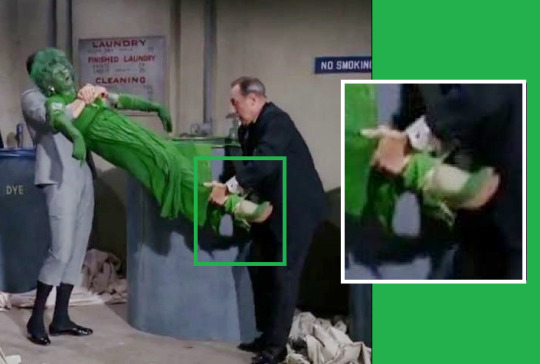
Color Correction! When Lucy is lifted out of the vat, viewers can see that her tights and the soles of her shoes are not green!
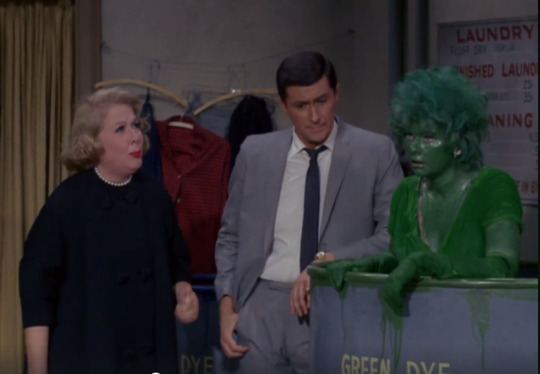
Gimme a Sign! Why is there a sign with prices for cleaning services posted in the back room of the laundry, where no customers will ever see it?
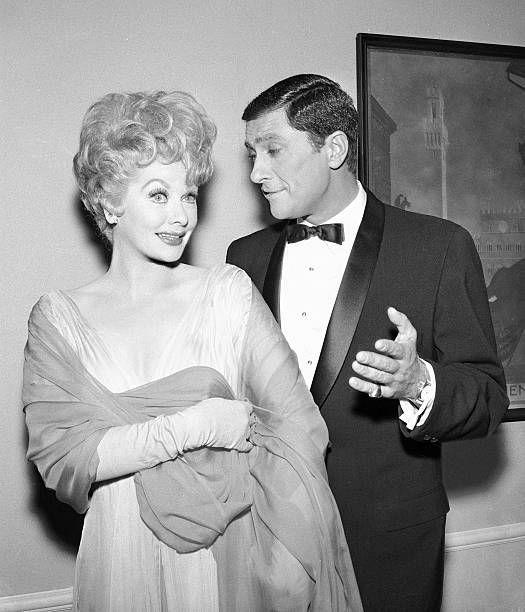

“Lucy Meets a Millionaire” rates 4 Paper Hearts out of 5
#The Lucy Show#Lucy Meets a Millionaire#Cesare Danova#Lucille Ball#Vivian Vance#Gale Gordon#1964#TV#CBS#Jay Novello#Bert Stevens#Steve Carruthers#Jean Vachon#James Gonzales#St. Patrick's Day#Green Dye#Italian#Dry Cleaner
2 notes
·
View notes
Text

Bad movie I have The Twilight Zone : Christmas Exisodes it has The Night of the Meek 1960 and Five Characters in Search of an Exit 1961
#The Twilight Zone : Christmas Exisodes#The Night of the Meek#Art Carney#John Fiedler#Robert P. Lieb#Val Avery#Meg Wyllie#Kay Cousins Johnson#Burt Mustin#Steve Carruthers#Jimmy Garrett#Larrian Gillespie#Nan Peterson#Rod Serling#Jack Kenny#Five Characters in Search of an Exit#Susan Harrison#William Windom#Murray Matheson#Kelton Garwood#Clark Allen#Carol Hill#Mona Houghton
1 note
·
View note
Link
Steve Ayan of Scientific American interviewed philosopher Peter Carruthers, who insists that the basis of all our thinking is unconscious, out of sight.
Steve Ayan: You call the process of how people learn their own thoughts interpretive sensory access, or ISA. Where does the interpretation come into play?
Peter Carruthers: Let’s take our conversation as an example—you are surely aware of what I am saying to you at this very moment. But the interpretative work and inferences on which you base your understanding are not accessible to you. All the highly automatic, quick inferences that form the basis of your understanding of my words remain hidden. You seem to just hear the meaning of what I say. What rises to the surface of your mind are the results of these mental processes. That is what I mean: The inferences themselves, the actual workings of our mind, remain unconscious. All that we are aware of are their products. And my access to your mind, when I listen to you speak, is not different in any fundamental way from my access to my own mind when I am aware of my own inner speech. The same sorts of interpretive processes still have to take place.
SA: Why, then, do we have the impression of direct access to our mind?
PC: The idea that minds are transparent to themselves (that everyone has direct awareness of their own thoughts) is built into the structure of our “mind reading” or “theory of mind” faculty, I suggest. The assumption is a useful heuristic when interpreting the statements of others. If someone says to me, “I want to help you,” I have to interpret whether the person is sincere, whether he is speaking literally or ironically, and so on; that is hard enough. If I also had to interpret whether he is interpreting his own mental state correctly, then that would make my task impossible. It is far simpler to assume that he knows his own mind (as, generally, he does). The illusion of immediacy has the advantage of enabling us to understand others with much greater speed and probably with little or no loss of reliability. If I had to figure out to what extent others are reliable interpreters of themselves, then that would make things much more complicated and slow. It would take a great deal more energy and interpretive work to understand the intentions and mental states of others. And then it is the same heuristic transparency-of-mind assumption that makes my own thoughts seem transparently available to me.
[...]
SA: What side effect does the illusion of immediacy have?
The price we pay is that we believe subjectively that we are possessed of far greater certainty about our attitudes than we actually have.
It takes the noodling of a philosopher to remind us that 'the heart has its reasons that reason knows not'. (Blaise Pascal)
408 notes
·
View notes
Note
Steve the drag racer for the WIP game?
I think this fic would be all dialogue if I could have it make sense.
WIP Wednesday
“Sure would, Sweetheart.” He stubs out the joint, hopefully somewhere near the ashtray and not on Mrs. Harrington’s upsettingly white shag rug. He is way too far gone if he’s letting himself call Steve names like that.
Robin slices through the air above her, sharp like Mrs. Carruthers' conducting. “When did Steve drive a tractor?”
3 notes
·
View notes
Photo

There Is No Such Thing as Conscious Thought (Steve Ayan and Peter Carruthers, Scientific American, Dec 20 2018)
“In ordinary life we are quite content to say things like “Oh, I just had a thought” or “I was thinking to myself.”
By this we usually mean instances of inner speech or visual imagery, which are at the center of our stream of consciousness—the train of words and visual contents represented in our minds.
I think that these trains are indeed conscious. In neurophilosophy, however, we refer to “thought” in a much more specific sense.
In this view, thoughts include only nonsensory mental attitudes, such as judgments, decisions, intentions and goals.
These are amodal, abstract events, meaning that they are not sensory experiences and are not tied to sensory experiences.
Such thoughts never figure in working memory. They never become conscious.
And we only ever know of them by interpreting what does become conscious, such as visual imagery and the words we hear ourselves say in our heads. (…)
All the highly automatic, quick inferences that form the basis of your understanding of my words remain hidden.
You seem to just hear the meaning of what I say. What rises to the surface of your mind are the results of these mental processes.
That is what I mean: The inferences themselves, the actual workings of our mind, remain unconscious. All that we are aware of are their products.
And my access to your mind, when I listen to you speak, is not different in any fundamental way from my access to my own mind when I am aware of my own inner speech.
The same sorts of interpretive processes still have to take place. (…)
Moreover, if introspection were fundamentally different from reading the minds of others, one would expect there to be disorders in which only one capacity was damaged but not the other.
But that’s not what we find. Autism spectrum disorders, for example, are not only associated with limited access to the thoughts of others but also with a restricted understanding of oneself.
In patients with schizophrenia, the insight both into one’s own mind and that of others is distorted.
There seems to be only a single mind-reading mechanism on which we depend both internally and in our social relations.”
44 notes
·
View notes
Note
Favourite 5 mmni characters? (Sorry if you’ve already answered it)
ooo, interesting question! my favourite characters are usually the “iconic” ones, so my answers are a little bit boring, but here you are.
1. vivian the goblin from primary cape crusader, he is sure to make me laugh every single time (thank u josh)
2. lawrence dallaglio from the ashopalypse trilogy, the man the myth the legend
3. delta von tassel from flat pack attack, how was i NOT meant to include him?
4. carruthers carruthers from pier today gone tomorrow, matt cavendish absolutely killing it in his first show
5. steve peeps from enter the elephant, ellie morris is underratedly funny
#as i said#these are quite boring answers#but 🤷♀️#also out of curiosity#was this for an ask game?#i don’t remember reblogging anything recently#it’s fine bc i love answering asks#i just can’t quite remember if i had reblogged something#thanks for the ask!#cornleykillercanary
15 notes
·
View notes
Video
youtube
Press Your Luck (1983) - intro and open
#Press Your Luck#Peter Tomarken#Rod Roddy#Whammy#Savage Steve Holland#Second Chance#Bill Carruthers#Jan McCormack#Bill Kopp#80s#tv#game shows#intros#CBS#animation#cartoons
3 notes
·
View notes
Text
Master List of Books
Here is the master list of books to read. Please support black authors by visiting your library or purchasing these instead of downloading!
Intro to Black Radical Politics
assata: autobiography
angela davis an autobiography
angela davis: freedom is a constant struggle
huey p newton: revolutionary suicide
what is marxism all about?
beginners guide to marxism
huey p newton: to die for the people, collected writings
w.e.b du bois: w.e.b du bois speaks
the autobiography of malcom x
muammar gaddafi: the green book
walter rodney: groundings with my brothers
lenin: state and revolution
kwame ture: stokely speaks, from black power to pan-africanism
thomas sankara: women’s liberation and the african freedom struggle
harry haywood: black bolshevik
w.e.b. du bois: essay collection
debunking anti-communism myths & propaganda
karl marx & frederick engels: the communist manifesto
joseph stalin: dialetical & historical materialism
reading marx’s “capital” with david harvey
marxism-leninism study guide
basic marxism-leninism study plan
paulo freire: pedagogy of the oppressed
michael parenti: left anticommunism
Black and Marxist Feminism
keeanga-yamahtta taylor: how we get free, black feminism and the combahee river collective
bell hooks: yearning; race, gender, and cultural politics
oyèrónkẹ́ oyěwùmí: african women and feminism
audre lorde: sister outsider
claudia jones: an end to the neglect of the negro woman!
silvia federici: caliban and the witch
audre lorde: i am your sister
bell hooks: ain’t i a woman, black women and feminism
angela davis: modern motherhood, women and family in england
Prison Abolition
george jackson: blood in my eye
soledad brother: the prison letters of george jackson
angela davis: are prisons obsolete?
angela davis: political prisoners, prisons, and black liberation
paula c. johnson: voices of african american women in prison
On Racial Capitalism
jackie wang: carceral capitalism
e. franklin fraizer: black bourgeoisie
robin d.g. kelley: hammer and hoe
cedric j. robinson: black marxism
Critical Race Class Studies
w.e.b. du bois: black reconstruction
frantz fanon: black skin, white masks
patrick wolfe: traces of history; elementary structures of race
Black Studies Manifesto- Darlene Clark
Criteria of Black Art- W.E.B Dubois
Lynch Law- Ida B. Wells
On Being White and Other Lies- James Baldwin
James Baldwin Speech from 1965 Debate
The American Dream and the American Negro- James Baldwin
The Souls of Black Men- Hazel Carby
The Case for Reparations- Ta Nehisi Coates
Cultural Identity and the Diaspora- Stuart Hall
The Fact of Blackness- Franz Fanon
Negritude
Fragments of Epic Memory- Derek Walcott
The Groundings with My Brothers- Walter Rodney
The Politics of Healing in the Black Lives Movement- Deva Woodley
Unapologetic- Charlene Carruthers
Emergent Strategy- Adrienne Maree Brown
The Use of the Erotic as Power- Audre Lorde
On Capitalism, Fascism, Imperialism, Neocolonialism, Settler-Colonialism
frantz fanon: the wretched of the earth
walter rodney: how europe underdeveloped africa
eduardo galeano: open veins of latin america
samir amin: eurocentrism
michael parenti: blackshirts & reds
glen sean coulthard: red skin, white masks
clr james: the black jacobins
chris harman: a people’s history of the world
“decolonization is not a metaphor”
Indigenous Studies
nick estes: our history is the future
“decolonization is not a metaphor”
oyèrónkẹ́ oyěwùmí: women in the yoruba sphere
On Revolution:
frantz fanon: towards the african revolution
kwame nkrumah: africa must unite
black panthers speak
kwame ture: ready for revolution
steve biko: i like what i like; selected writings
black like mao, red china & black revolution
che guevera: guerilla warfare
walter rodney: a history of the guyanese working people, 1881-1905
return to the source – selected speeches by amilcar cabral
https://dialecticalartist.wordpress.com/politicalresources/
On Slavery:
stephanie e. jones-rogers: they were her property
Whiteness Studies
nell irvin painter: the history of white people
theodore w allen: the invention of the white race volume I
theodore w allen: the invention of the white race volume II
david r. roediger the wages of whiteness
david r. roediger: seizing freedom, slave emancipation & liberty for all
karen brodkin: how jews became white folks & what that says about race in america
On Gender, Sexuality, and Masculinities
c. riley snorton: black on both sides a racial history of trans identity
essex hemphill: ceremonies
robert f. reid-pharr: black gay man, essays
bell hooks: we real cool
maria lugones: heterosexualism and the colonial modern gender system
marlon m. bailey: butch queens up in pumps: gender, performance, and ballroom culture in detroit
robert aldrich: colonialism and homsexuality
eve kosofsky sedgwick: epistemology of the closet
https://www.aaihs.org/excavating-black-queer-thought-a-pride-bibliography/
“the roots of lesbian & gay oppression: a marxist view” by bob mccubbin
afsaneh najmabadi: women with mustaches and men without beards: gender and sexual anxieties of iranian modernity
anne mcclintock: imperial leather: race, gender, and sexuality in the colonial conquest
oyèrónkẹ́ oyěwùmí: gender epistemologies in africa
oyèrónkẹ́ oyěwùmí: the invention of women: making african sense of western gender discourses
oyèrónkẹ́ oyěwùmí: african gender studies a read
oyèrónkẹ́ oyěwùmí: the invention of women
oyèrónkẹ́ oyěwùmí: what gender is motherhood?
Disability Studies
disability studies
Critical Reads
marx’s das kapital for beginners
black panther ten point program
Articles, Speeches, and Essays
w.e.b. du bois: essay collection
amiri baraka: essay collection
james baldwin: the free and the brave
adrienne rich: compulsory heteorsexuality and lesbian existence
david m. halperin: essay collection
e. patrick johnson: black queer studies a critical anthology
stuart hall: essay collection
audre lorde: the masters tools will never dismantle the master’s house
kwame nkrumah: axioms of kwame nkrumah
angela davis essays on liberation
clr james: black power, its past, today, and the way ahead
edward said’s lecture at york university
kwame ture: we are all africans
the death of stockley carmichael (and later kwame ture)
raewyn connell essay collection
stalin: marxism versus liberalism
what is dialectical materialism?
racism in the communist movement
the logic of lesser evilism
lenin: the three sources and three component parts of marxism
oyèrónkẹ́ oyěwùmí: de-confounding gender: feminist theorizing and western culture,
Cultural Texts
Bell hooks: all about love
James Baldwin
go tell it on the mountain
giovanni's room
another country
the fire next time
if beale street could talk
Sonny’s blues
just above my head
notes of a native son
nobody knows my name
rap on race
no name in the street
a dialogue
devil finds work
the evidence of things not seen
baldwin: collected essays
the cross of redemption
Toni Morrison
the bluest eye (1969)
sula (1971)
song of solomon (1977)
beloved (1986)
paradise (1997)
a mercy (2008)
the source of self-regard: selected essays, speeches, and meditations (2019) V
24 notes
·
View notes